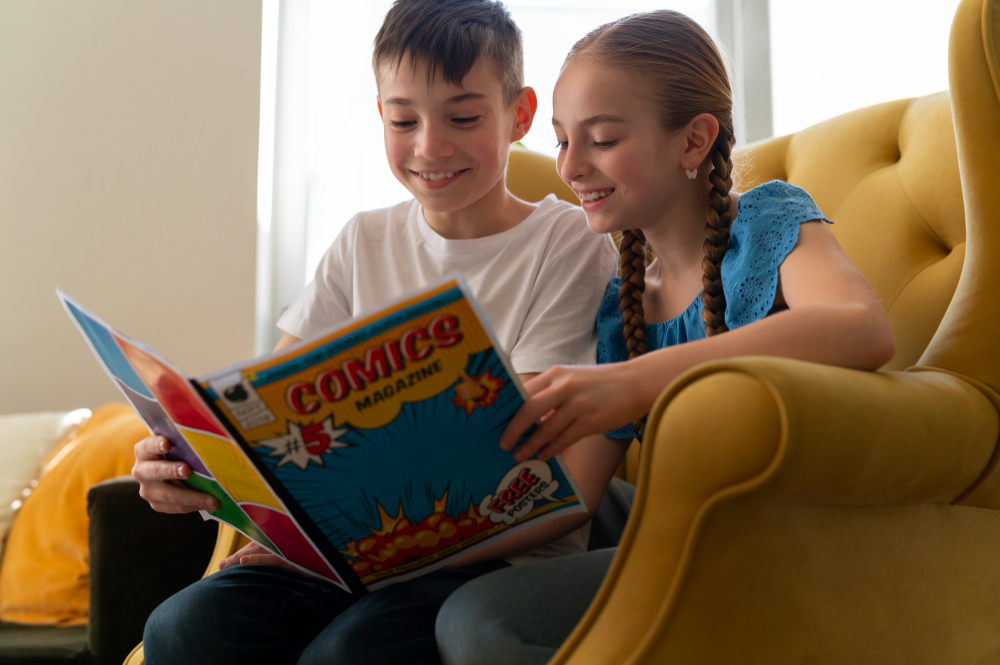Reading a captivating mystery or an epic fantasy not only serves as a fun diversion but also serves as a powerful brain workout for your child.
Yet many parents view fiction as pure entertainment, separate from “real” learning. They might see math, science, or homework as the places where problem-solving happens, while stories are treated as a reward after the “serious” work is done.
The truth? Fiction is one of the best tools for developing the very skills your child needs to thrive: creativity, logic, resilience, and adaptability.
In this article, we’ll explore how reading stories rewires the brain, trains problem-solving abilities, and prepares your child for real-world challenges.
The Cognitive Leap: How Fiction Rewires the Brain
- Mental Simulation
When your child reads a story, they aren’t just passively absorbing words. They are actively simulating the characters’ experiences in their minds—imagining how it feels to face danger, solve puzzles, or make difficult choices. This process engages multiple parts of the brain, from language centers to sensory and emotional regions.
In other words, reading fiction is like running “mental experiments” in a safe environment.
- Cause and Effect Thinking
Stories are built on cause and effect: Because this happened, that happened next. A child who follows a narrative is constantly practicing logical sequencing and predicting outcomes.
When they read a mystery, for example, they’re piecing together clues to figure out who committed the crime. When they read a fantasy, they’re tracking how one character’s choices affect an entire kingdom.
This trains the brain to think in chains of logic—an essential skill for solving problems in real life.
- Narrative Closure
Our brains crave resolution. When a child starts a story, they feel a natural pull to see how it ends. This drive for “narrative closure” encourages persistence, even when the text is challenging.
That perseverance transfers outside of books. A child who learns to stick with a long, complex story is also practicing the patience and focus needed to tackle difficult homework, build a science project, or solve a tough math problem.
The Three C’s: The Problem-Solving Skills Gained from Fiction
- C-1: Creative Thinking
When a child reads about fantastical worlds, magical powers, or surprising plot twists, they’re forced to stretch their imagination. They must consider possibilities beyond the obvious and sometimes even suspend the rules of reality.
In a nutshell: Fiction trains kids to think outside the box—an essential skill when facing problems that don’t have a straightforward answer.
- C-2: Critical Analysis
A well-written story requires readers to dig deeper. Kids analyze characters’ motivations, track subtle clues, and connect information across chapters to fully understand what’s happening.
In summary: This builds critical thinking, the ability to question, evaluate, and interpret information—a cornerstone of effective problem-solving.
- C-3: Cognitive Flexibility
Stories often shift perspectives or force readers to understand situations through someone else’s eyes. Maybe the “villain” turns out to have a sympathetic backstory, or a hero must change strategies mid-journey.
In summary, fiction fosters cognitive flexibility, which is the ability to adapt to new information, modify plans, and approach problems from various perspectives.
Putting It Into Practice: From Book to Brain
Fiction naturally builds these skills, but parents can make the process even more powerful with a few intentional strategies:
- Tip 1: Ask “What Would You Do?”
While reading, pause and ask your child:
- “What would you do if you were in this character’s shoes?”
- “How would you solve this problem differently?”
This simple practice encourages active problem-solving instead of passive reading.
- Tip 2: Connect Stories to Life
Draw parallels between fictional conflicts and real-world challenges your child has faced. For example:
- “Remember when you felt nervous starting a new school? How is that like the character moving to a new city?”
- “This character needed to collaborate with others, just like you did in your soccer match last week.”
Making these connections helps children see stories as practice for life.
- Tip 3: Discuss Character Motivations
Go beyond what happened and ask why. Questions like:
- “Why do you think the character made that choice?”
- “What were they hoping would happen?”
- “Was there another path they could have taken?”
These conversations deepen empathy, sharpen reasoning, and encourage your child to see problems from multiple perspectives.
Speak to a Reading Expert
When your child picks up a book, they’re doing more than following a story—they’re training their brain to solve problems. Fiction strengthens creativity, critical thinking, and flexibility—the very skills they’ll need to face real-world challenges with confidence.
Final message: The books on your child’s shelf aren’t just stories; they’re training manuals for life. Solving each mystery, following each adventure, and understanding each character prepares your child for the challenges and opportunities ahead.
At Read Smart, we know that reading isn’t just about words on a page—it’s about building the skills that shape a child’s future.
Our personalized programs don’t just help kids improve literacy; they strengthen the creativity, logic, and problem-solving skills that fiction unlocks.
Ready to give your child the tools for success? Schedule a FREE reading evaluation with Read Smart today and discover how the power of stories can prepare them for a lifetime of smart, confident problem-solving.

